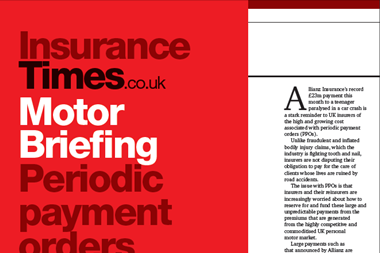Deloitte’s figures show a marked improvement in combined ratio, but these days insurers can’t rely on investments to make a profit
The UK’s motor insurers should be encouraged by accounting firm Deloitte’s proclamation that the sector’s combined ratio fell to 106% in 2011 from 120% in 2010.
The 14 percentage point improvement shows that all the pain insurers have gone through in the last two years – sacrificing premium growth by cutting poorly performing business and risking the wrath of brokers and clients by exiting unprofitable relationships and raising prices – is paying off.
The Deloitte ratio incorporates both commercial and personal lines, so indicates the headway being made in both areas.
Insurers should not get complacent, however, as the 106% figure also shows that UK motor is still not fixed. Insurers are still losing £1.06 for every £1 of premium they bring in from motor. And with interest rates still stubbornly low, with no sign of an uplift, investment returns are not enough to cover this.
In the past, insurers have been able to afford combined ratios of around the break-even 100% mark or even just above because they knew investment returns would make up for it. Times have changed, though, and many now shoot for maximum combined ratios of around the 95% mark to ensure an adequate profit. So there is still quite a way to go.
Also, while prices are now almost right – judging by the fact that rate increases have slowed – and concerted industry and government efforts to tackle bodily injury claims are underway, there is still considerable uncertainty.
Increasing use of periodic payment orders to settle bodily injury claims is a big concern for UK insurers and their reinsurers, as it is even more difficult than usual to predict what he ultimate pay-out will be.
As actuarial consultancy Towers Watson has pointed out, this uncertainty, coupled with the fact that there are currently no assets insurers can buy to match their PPO liabilities, is playing havoc with insurers’ investment strategies.
In addition, because the Deloitte calculation includes personal and commercial lines, it is unclear to what extent one is propping up or holding back the other.
Insurers should be wary of celebrating this improvement. If they shout too loud, they will face a clamour from all sides to lower rates, which it is arguably too early to do. They need to be very clear – 106% is better than it was, but it’s still not good.
Aviva to sell overseas operations
Elsewhere, John McFarlane’s plans for Aviva’s future shape have started to emerge, with indications this morning that Aviva is looking to sell operations in Sri Lanka, South Korea and Ireland.
Details about potential changes were sketchy when McFarlane addressed journalists and analysts as the first-quarter results were released. However, these revelations show that McFarlane will not be taking it easy during his interim stewardship of the company and is taking decisive action.
Investors are wary of Aviva at the moment because of its high eurozone exposure. Perhaps this news will give them a glimmer of hope that efforts are being made to bolster Aviva’s capital base.
Hosted by comedian and actor Tom Allen, 34 Gold, 23 Silver and 22 Bronze awards were handed out across an amazing 34 categories recognising brilliance and innovation right across the breadth of UK general insurance.













































No comments yet